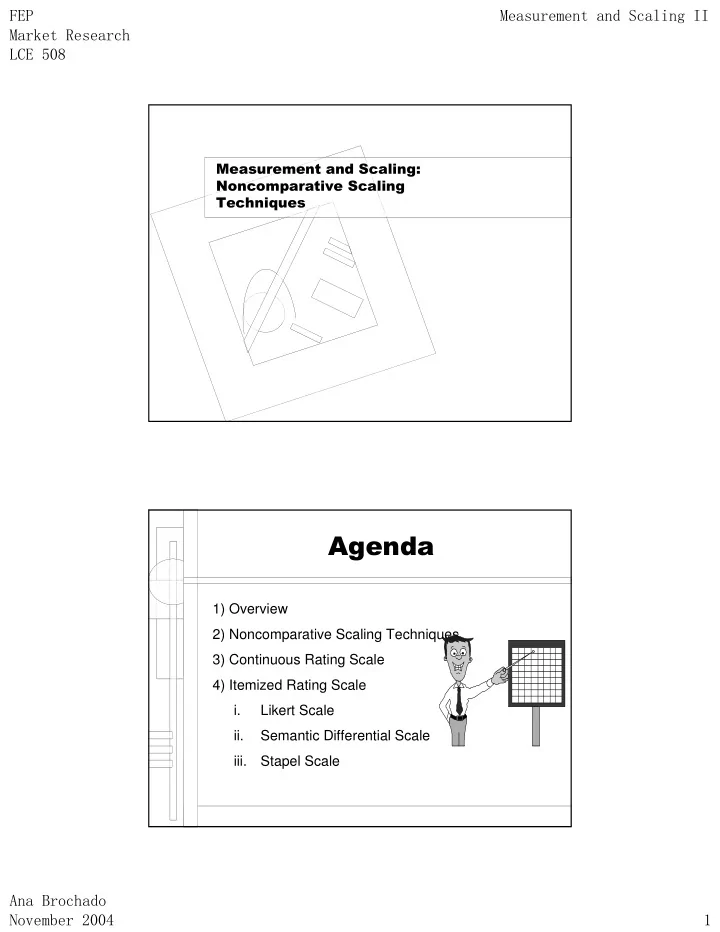

��� �������������������������� ��������������� ������� ������������������������ �������������� ������� ���������� ������ 1) Overview 2) Noncomparative Scaling Techniques 3) Continuous Rating Scale 4) Itemized Rating Scale i. Likert Scale ii. Semantic Differential Scale iii. Stapel Scale ������������ ������������� �
��� �������������������������� ��������������� ������� ������ 5) Noncomparative Itemized Rating Scale Decisions i. Number of Scale Categories ii. Balanced vs. Unbalanced Scales iii. Odd or Even Number of Categories iv. Forced vs. Non-forced Scales v. Nature and Degree of Verbal Description vi. Physical Form or Configuration 6) Multi-item Scales �������������� �������� ���������� • Respondents evaluate only one object at a time, and for this reason noncomparative scales are often referred to as monadic scales. • Noncomparative techniques consist of continuous and itemized rating scales. ������������ ������������� �
��� �������������������������� ��������������� ������� Basic non-comparative scales ������������������������� ������������������� �� ����������� ���� ��������� ������ ���� ����������� ���������� ��������� ����������� ������������������������������ ��������������������������������������������������� ������������������������������������������������������������������������������������� ��������� �� ��!������ ������� � "���� ������������ ��� ������ �� ����� ���� ����������� �� ��������������������������������������������������������#����������� ��� ��������������������������������������� ���������������������������������������� ��#�������������!#�!���������������� ���������������������������������������#������ ������������������������������������������� �����������#�������������������������������� �����������$�������������������������� ����������������������������������������� �������������������������������������������� ��������������������#��#��%��������#�� �����������������������������������&����� �������������� ������������ ������������� �
��� �������������������������� ��������������� ������� ����������������������� Respondents rate the objects by placing a mark at the appropriate position on a line that runs from one extreme of the criterion variable to the other. The form of the continuous scale may vary considerably. How would you rate Sears as a department store? Version 1 Probably the worst - - - - - - -I - - - - - - - - - - - - - - - - - - - - - - - - - - - - - - - - - - - - - - Probably the best Version 2 Probably the worst - - - - - - -I - - - - - - - - - - - - - - - - - - - - - - - - - - - - - - - - - - - -- - Probably the best 0 10 20 30 40 50 60 70 80 90 100 Version 3 Very bad Neither good Very good nor bad Probably the worst - - - - - - -I - - - - - - - - - - - - - - - - - - - - - -- - - - - - - - - - - - - - - - -Probably the best 0 10 20 30 40 50 60 70 80 90 100 ���������������������� • The respondents are provided with a scale that has a number or brief description associated with each category. • The categories are ordered in terms of scale position, and the respondents are required to select the specified category that best describes the object being rated. • The commonly used itemized rating scales are the Likert, semantic differential, and Stapel scales. ������������ ������������� �
��� �������������������������� ��������������� ������� �!��� ����� The Likert scale requires the respondents to indicate a degree of agreement or disagreement with each of a series of statements about the stimulus objects. Strongly Disagree Neither Agree Strongly disagree agree nor agree disagree 1. FNAC sells high quality products. 1 2X 3 4 5 2. FNAC has poor in-store service. 1 2X 3 4 5 3. I like to shop at FNAC . 1 2 3X 4 5 • The analysis can be conducted on an item-by-item basis (profile analysis), or a total (summated) score can be calculated. • When arriving at a total score, the categories assigned to the negative statements by the respondents should be scored by reversing the scale. The Likert scale ������������ ������������� �
��� �������������������������� ��������������� ������� �"������ NEW FRAGANCE SURVEY Strongly Disagree Neither Agree Strongly disagree agree nor agree disagree 1. I usually buy may fragrances in a department store 2. I usually buy may fragrances in a supermarket 3. I only buy one brand of fragrance 4. I would be interested in a new fragrance 5. I frequently try new fragrances JOB SATISFACTION 1. I get a feeling of accomplishment from the work I am doing ���������#�$$��������� ����� The semantic differential is a seven-point rating scale with end points associated with bipolar labels that have semantic meaning. SEARS IS: Powerful --:--:--:--:-X-:--:--: Weak Unreliable --:--:--:--:--:-X-:--: Reliable Modern --:--:--:--:--:--:-X-: Old-fashioned • The negative adjective or phrase sometimes appears at the left side of the scale and sometimes at the right. • This controls the tendency of some respondents, particularly those with very positive or very negative attitudes, to mark the right- or left-hand sides without reading the labels. • Individual items on a semantic differential scale may be scored on either a -3 to +3 or a 1 to 7 scale. • The resulting data are commonly analyzed through Profile analysis. ������������ ������������� �
Recommend
More recommend